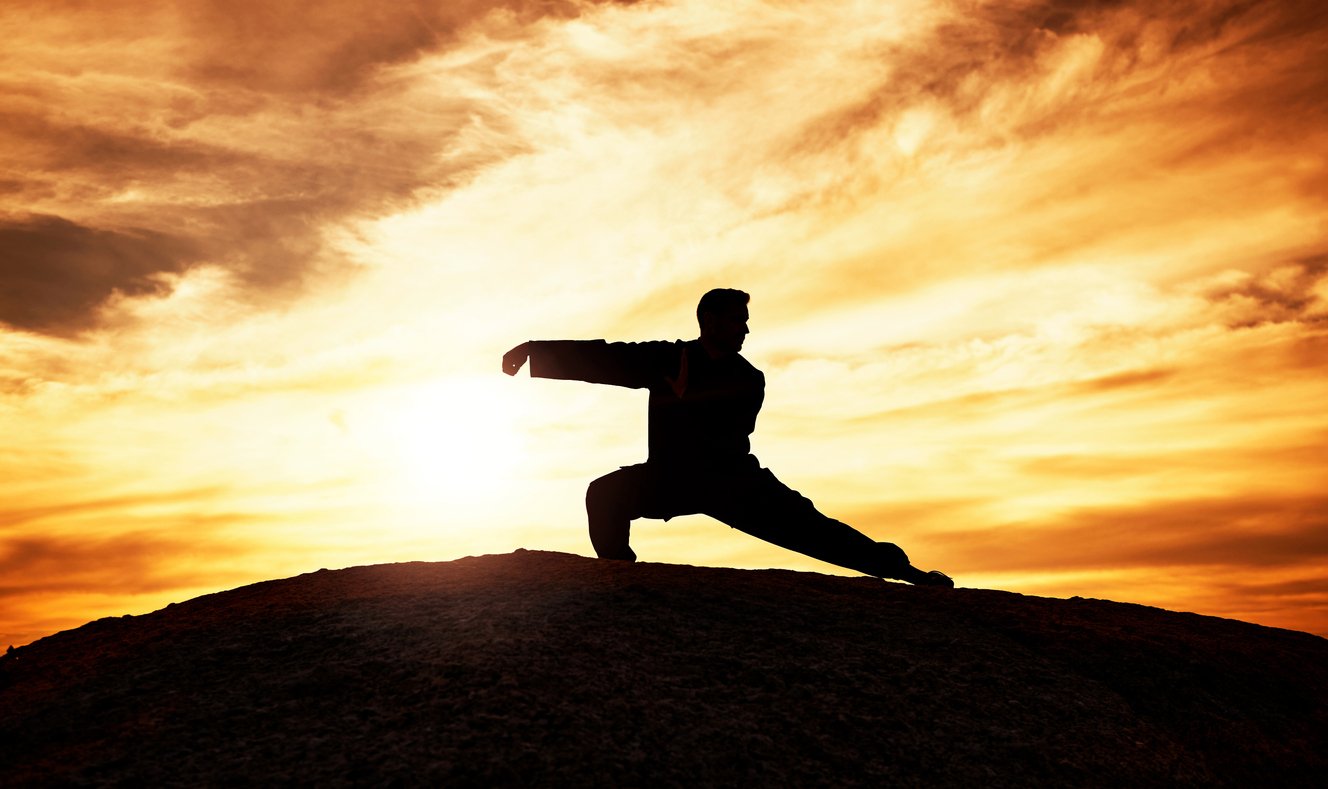
Taijiquan (Tai Chi)
About Taijiquan
All Current Classes are Available via Online Interactive Streaming Video
The full name of this ancient Chinese martial art is Taijiquan (Wade-Giles romanization, Tai Chi Chuan). In English, the correct pronunciation is usually “Tie” (as in bow tie) “Gee” (as in Gee Wiz) “Chwan” (with a long “a” sound, as in want). It is most correctly translated as “Great Extremes System” or “Great Extremes Boxing.”
Taijiquan is most often referred to as an internal martial art, indicating that the emphasis is placed on strengthening the mind, circulating the Qi (pronounced “CHEE”) or vitality, and relaxing the body so that it is free to move. Beyond its martial applications, however, Taiji is also a complete system of physics and philosophy, best characterized by the Taiji symbol known to Americans as the Yin-Yang circle (shown in the left margin of this page).
In the Taiji symbol, two semicircles of dark (Yin) and light (Yang) make a complete circle as they constantly merge into each other, symbolizing the spirit of “moving harmony.” This harmony of motion succinctly describes the laws of Yin and Yang which assert that in the phenomenal world (both physical and energetic) all existence is a relationship between complimentary but opposing pairs. This can be observed daily in the relationship between night/day, winter/summer, female/male, negative/positive, and countless others. In this system, Yang represents all that is expressive, productive and strength-oriented. Its opposite, Yin, is receptive, yielding and internal.
In the martial aspect of Taiji, the relationship between the yielding force of Yin and the unbending force of Yang forms the core of the martial art technique. The yielding force is used to avoid or redirect a partner’s applied energy, while the unbending force is used to return the partner’s energy to them as they find themselves in emptiness. This change from yielding to unbending is achieved in the form of a circle. Therefore, the main pattern of Taijiquan is like many circles spiraling continually without end. In application, these principles lead to a force which Taiji master Cheng Man Ching once described as “repelling 2,000 pounds with four ounces.”
The History of Taijiquan
The story and principles of Taijiquan have been handed down through the past millennium both orally and through the traditional writings of Taiji which are collectively referred to as the Classics. According to legend, Taijiquan was created at the end of the Sung Dynasty by a Taoist by the name of Chang Sen Feng. A Shaolin disciple, Chang left the temple because he felt that the fighting techniques developed there had become too harsh and brute strength oriented. In order to find a suitable martial art for himself and other Taoist monks, he journeyed to Wu Tang mountain and spent many years as a hermit, observing the habits of long-lived animals such as turtles and cranes. Learning and adapting these natural movements to the mechanics of the human body, and connecting them with the guiding principles of Taoism, Chang Sen Feng at last developed his Great Extremes System.
Eventually, Chang Sen Feng returned to the Shaolin temple where his new internal art (often called Wu Tang Boxing) was taught to Chang Sun Chi. At this point, the art consisted of only three techniques, with many fighting applications, and was called Lao San Dao (Old Three Cuts). Chang Sun Chi in turn taught Wang Tsung Yueh, who changed the art by developing it into 13 postures. The modified forms were taught to Jiang Fa, who later journeyed to the nearby Chen village and taught Chen Wang Ting.
Chen Wang Ting had been an army officer in Shan Tung Province in 1618, and had become an accomplished martial artist. When he returned to the Chen village in 1644, Chen took the Wu Tang internal boxing methods learned from Jiang Fa and began to refine and perfect them. He added postures from Sung Tai Tzu Quan and various Shaolin forms, and combined all these with classic Chinese internal health theories of passages of blood, air flow, and energy. His new art became Chen Chia Quan, now called Chen Taijiquan.
For generations, the art of Chen Taiji was a secret heritage of just a small number of families. Almost exclusively, parents passed the knowledge on to their children. During the 1700’s, Chen Wang Ting’s style had developed into the Five Routines of Pao Chuoi, a 32- and a 108-posture Taiji form, and one Duan Da (short strike) form. By the end of the century, the art had been passed to Chen Chang Shing who united and simplified the various routines.
Word began to spread about Chen Chang Shing’s martial art, and in the early 1800’s, reached Yang Lu Tsan (1799-1872). Yang Lu Tsan was a master of the Hung Quan Shaolin style, and became fascinated with the stories of the new internal art and it’s health benefits. Eager to learn, Yang Lu Tsan traveled to the Chen village to seek instruction from Chen Chang Shing. Officially, no outsiders were allowed to learn Chen style Taijiquan, so Yang Lu Tsan was forced to learn in secret. After mastering the art through 14 years of training, Yang Lu Tsan moved to Peking, where he began teaching Taijiquan. He noticed that the Chen style was very difficult to learn for the average practitioner, so he modified it for health purposes and ease of flow. His new system, formally called the Yang style, has since become the most popular of the Taijiquan styles in practice today.

